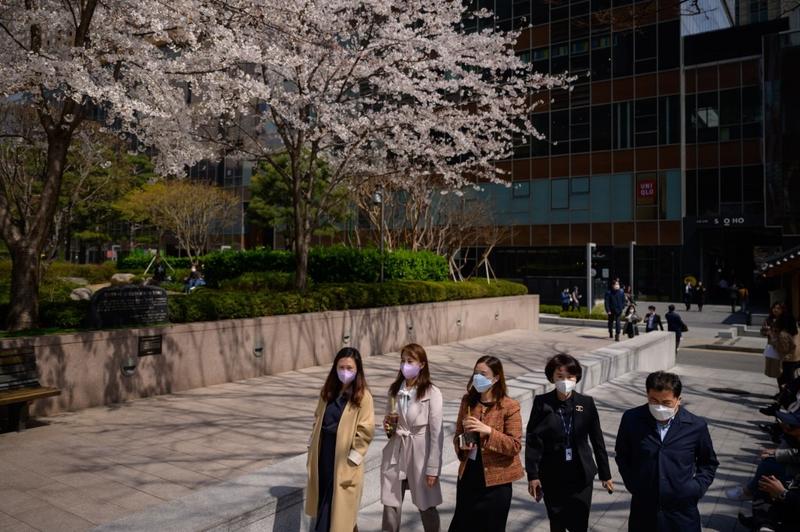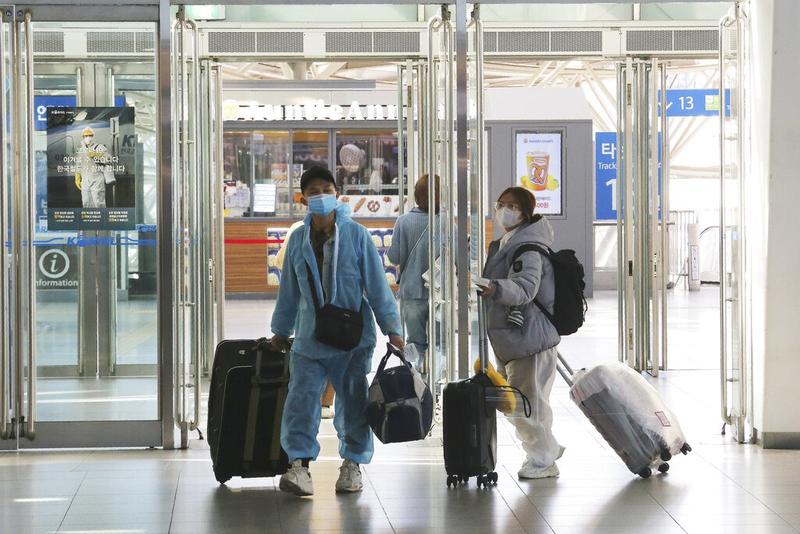 Office workers wearing face masks amid concerns over the COVID-19 novel coronavirus walk past blossoms during their lunch break in central Seoul on March 31, 2020. (Ed JONES / AFP)
Office workers wearing face masks amid concerns over the COVID-19 novel coronavirus walk past blossoms during their lunch break in central Seoul on March 31, 2020. (Ed JONES / AFP)
BUSAN, South Korea - Park Hyun stops to catch his breath after climbing a few steps to the entrance of the engineering college of the Pusan National University where he teaches. Despite a persistent shortness of breath, he uses the stairs and avoids elevators.
Park was Busan’s “Patient 47,” one of more than 5,000 South Koreans who have recovered from a coronavirus infection.
But 25 days after testing negative for the second time, he is in a new battle - against the stigma of having had the virus.
But 25 days after testing negative for the second time, he is in a new battle - against the stigma of having had the virus
“I do understand the concerns and anxiety of my colleagues and neighbors, so I only use the stairs in this university building, and even to my apartment on the ninth floor,” he said.
READ MORE: S. Korea's emergency exercise in Dec facilitated coronavirus testing
Park, 47, spent nine days in a special ward before being released, then spent 14 days in isolation plus 10 more days to recover his strength, but says many people around him still think of the disease first.
During his hospitalization, Park’s mother heard a neighbor screaming in front of their home: “We’re all going to die because of a son in this family.”
Park said he believed suspicions in the community run deeper because a large majority of the early outbreak was among the members of a secretive and controversial religious sect in the city of Daegu, about 100km northwest of Busan.
He says he decided to share his experience of the infection and the treatment he received to help dispel the mystery surrounding the epidemic. He has recorded the ups and downs of his fight with the disease on Facebook since day one.
“UNCERTAINTY BREEDS ANXIETY”
“By revealing my identity, I thought people would realize that I am not distributing fake news. Uncertainties are too high, and the anxieties are coming from uncertainties.”
Park’s colleagues welcomed him back to work on Monday but there were no hugs or handshakes
The pace of South Korea’s outbreak has slowed since the explosive increase in cases through February and early March, with 9,786 cases as of Tuesday. Some 5,408 patients have been released after testing negative.
Park’s colleagues welcomed him back to work on Monday but there were no hugs or handshakes. He eats a boxed lunch at the lab with his workmates, but uses a separate table several meters away from them. If any are worried about having him around, he says, they are doing a good job not showing it.
“There were some people who were tested positive again after full recovery. I am mindful of the people around me,” Park said, with a facial mask on at all time.
ALSO READ: Coronavirus fails to dampen South Korea's fever for exam success
Some discharged virus patients across the world including South Korea have been tested positive after recovering. The Korea Centers for Disease Control and Prevention said these cases require further epidemiologic study.
 A couple wearing face masks arrives to take train at the Seoul Railway Station in Seoul, South Korea, March 29, 2020. (PHOTO / AP)
A couple wearing face masks arrives to take train at the Seoul Railway Station in Seoul, South Korea, March 29, 2020. (PHOTO / AP)
“We are now back to normal but things are not the same as before - we used to debate sitting close to each other while using same keyboard, which is no longer possible since the outbreak,” a colleague, Professor Ahn Seok-young, said.
Park’s first task after resuming work was to make soap boxes using 3D printers to be donated with soap to the elderly in Busan and other cities affected by the outbreak.
“Many elderly in my city are living around the poverty line, having a problem buying hand sanitizers,” Park said. “We will also send soap and cases together to Daegu and other highly-affected areas.”


